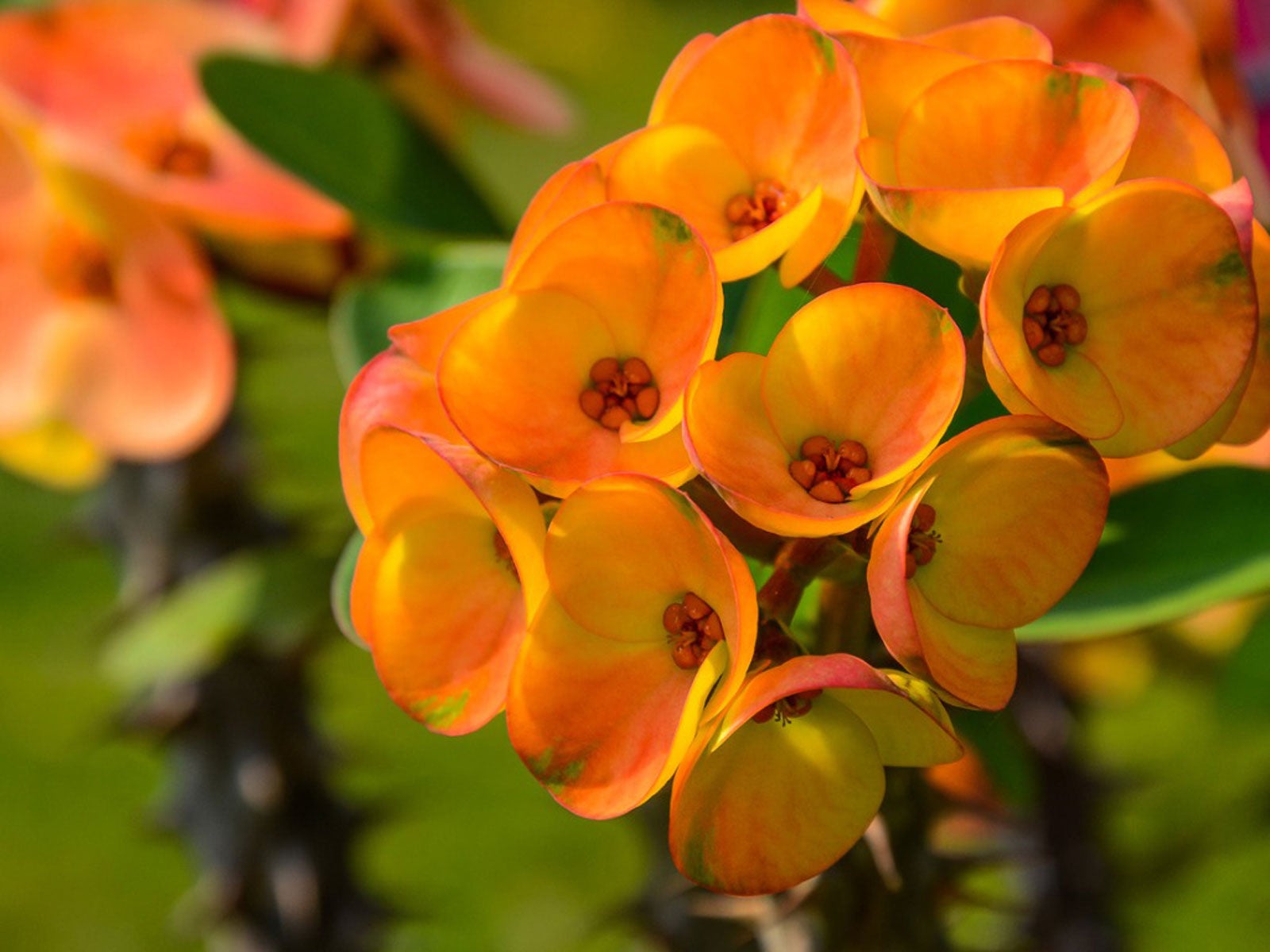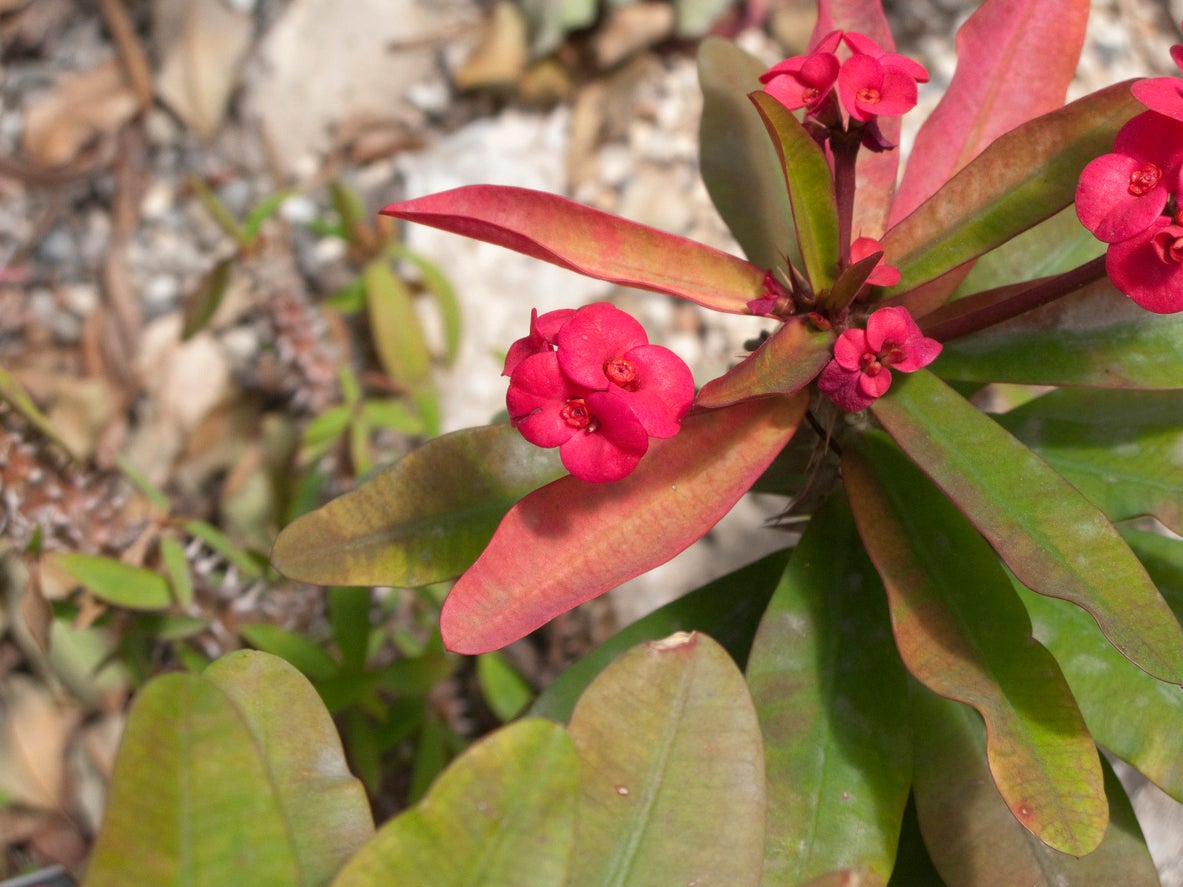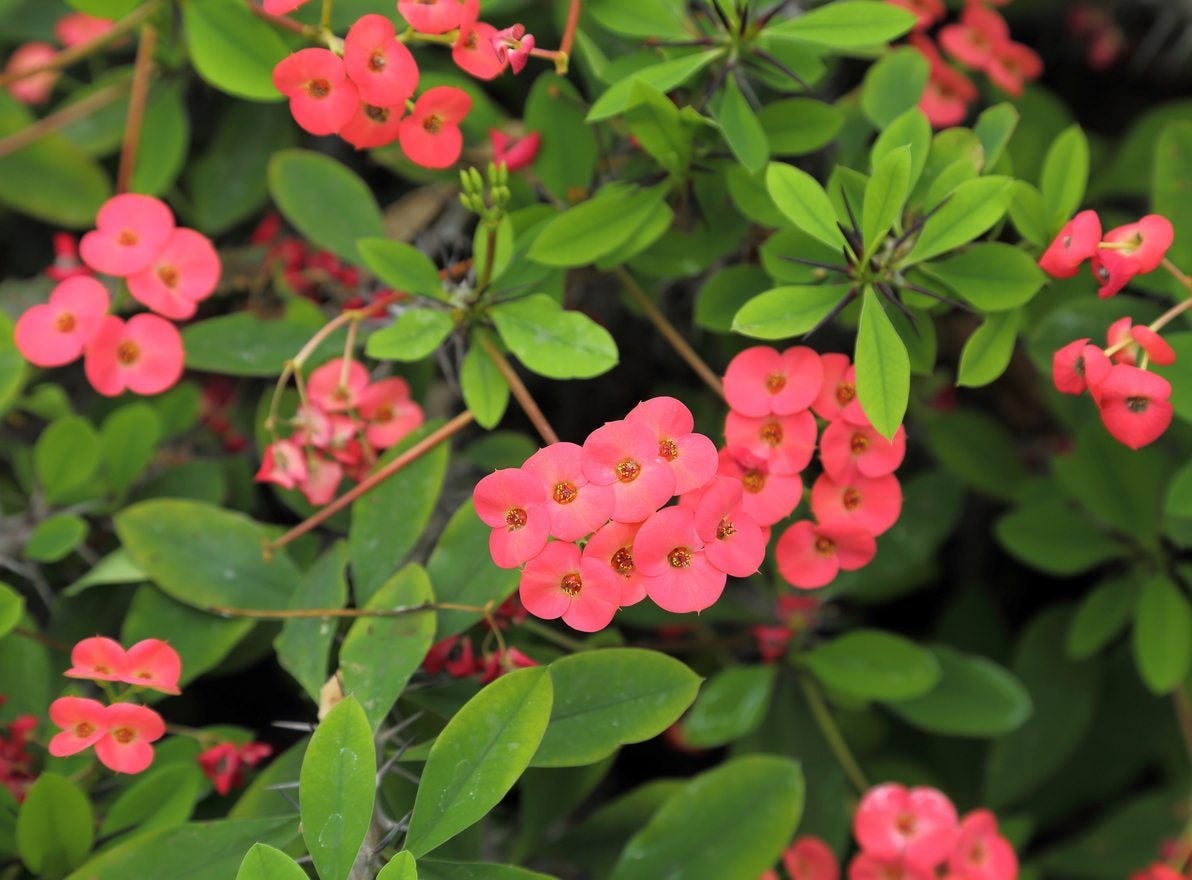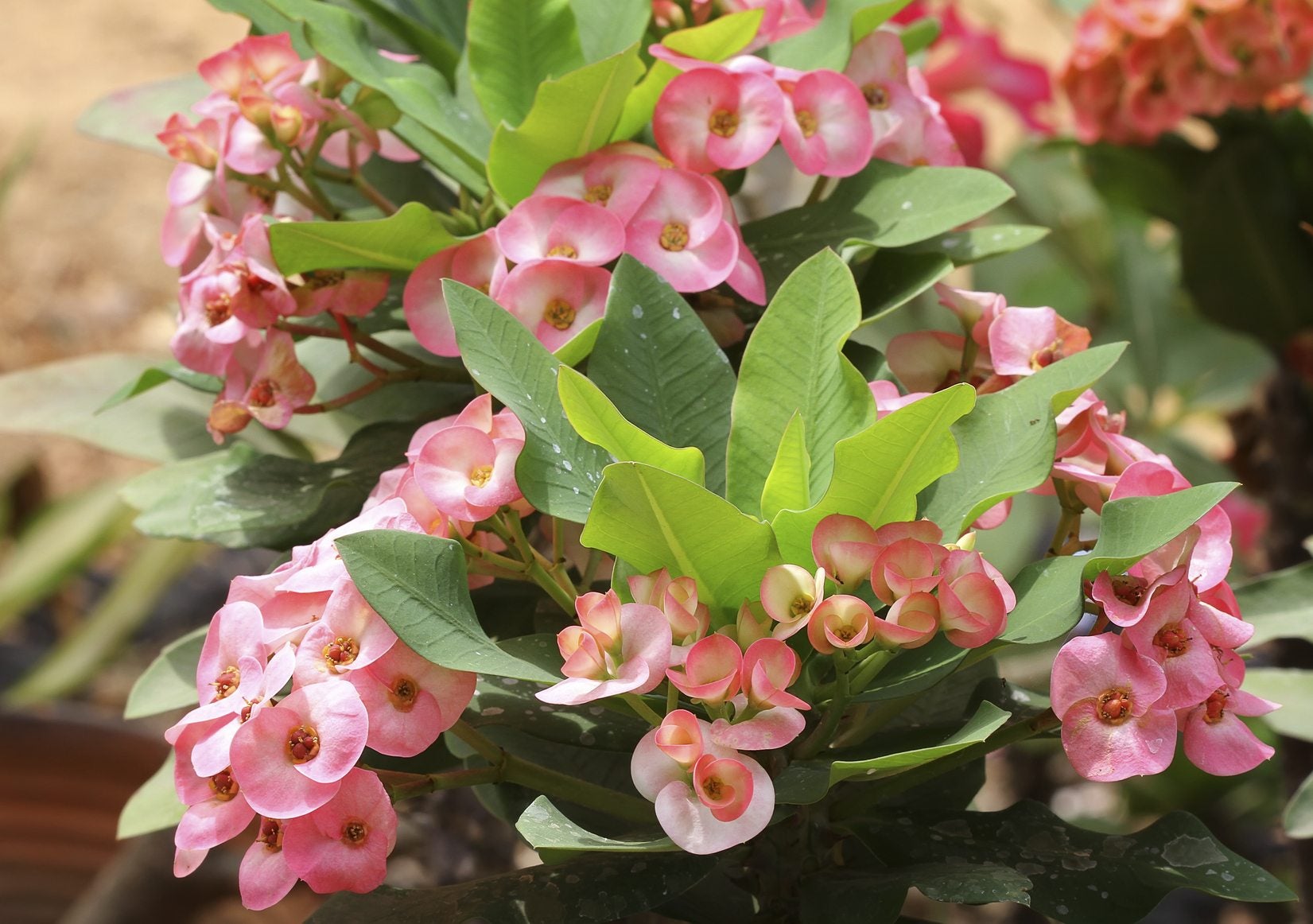Crown Of Thorns Plant, a Complete Indoor Care Guide
A crown of thorns plant will light up your home with its colorful blooms. It likes a dry indoor environment and is not particularly fussy.

How To Grow A Crown Of Thorns Plant Indoors
Crown of thorns, also known as Euphorbia milii and Christ thorn plant or Christ plant, is a woody, succulent shrub native to Madagascar. The crown of thorns flower is a popular houseplant in North America, known for its clusters of pretty, colorful blooms and its easy maintenance needs.
In Thailand some people say the number of flowers on a crown of thorns plant foretells the luck of the plant keeper. The plant has been improved over the years and now produces more and larger flowers than ever before. Hybrids of this plant bloom almost year-round.
Quick Facts
Botanical name: Euphorbia milii
Height: 3.0 to 6.0 feet (.90 to 1.8 m)
Spread: 1.5 to 3.0 feet (.50 to .90 m)
Sun exposure: Full sun
Soil requirements: Well drained
Gardening tips, videos, info and more delivered right to your inbox!
Sign up for the Gardening Know How newsletter today and receive a free copy of our e-book "How to Grow Delicious Tomatoes".
Hardiness zones: 9 to 11
When to plant: Spring, any time indoors
Crown of Thorns Plant Care Indoors
Crown of thorns plant care relies on providing this houseplant with adequate sunlight and warmth, and not too much water.
Light
To thrive and produce pretty flowers, a crown of thorns plant needs full sun. Place it by a window with at least four hours of bright, direct sunlight.
Water
Water crown of thorns plants when the soil is dry to a depth of an inch (2.5 cm). In winter, let the soil dry out down to two or three inches (5.0 to 7.5 cm). Water thoroughly, but don't let the plant sit in standing water.
Temperature & Humidity
Crown of thorns is a great houseplant for dry indoor air. It prefers dry conditions and needs good airflow. It can tolerate temperatures down to 50 degrees Fahrenheit (10 Celsius) but does best from 60 to 75 degrees (15 to 24 Celsius)
Soil
Potting soil for crown of thorns must drain very well. For the best results, use a soilless mix or a cactus and succulent mix.
Fertilizer
Use a general liquid fertilizer every few weeks during the growing season. Dilute the fertilizer by half for winter and apply only every month.
Problems, Pests & Diseases
Crown of thorns may be bothered by mites, scale, mealybugs, and thrips. The primary issue, however, is root rot and fungal diseases caused by overwatering, standing water, or too much humidity or too little airflow.
Pruning
Grown outdoors, crown of thorns is a small shrub. When grown as a houseplant, you can keep it smaller through careful pruning. Many hybrids grown today were bred to remain small and compact, so you likely do not need to prune often.
Be aware that the sap can irritate the skin, so where gloves and wash tools well after pruning.
Crown of Thorns Propagation
Repotting
You can successfully keep a crown of thorns in a smaller container to maintain a small size, and it will still produce flowers. Nonetheless, its a good idea to repot every few years to a slightly bigger container.
Overwintering
Only grow crown of thorns outdoors in beds in zones 9 through 11. In colder climates, you can grow plants outdoors in containers and bring them in for winter.
During the dormant season, potted crown of thorns still needs plenty of sunlight but need less watering and fertilizer. They will drop leaves but should revive in spring with more water and feeding.
Best Crown of Thorns Varieties to Grow Indoors
Pink Cadillac. Native crown of thorns are mostly red, but this variety produces bright pink flowers.
Gabriella. This variety is also pink and does particularly well in smaller containers.
Crème Supreme. For a creamy, white variety, try Crème Supreme.
Brush Fire. Brush Fire is a good variety for bright red blooms.
Zephyr. This cultivar has apricot-colored flowers with a unique bell shape.
Frequently Asked Questions
Is Crown of Thorns a Good Houseplant?
Crown of thorns is a fairly easy houseplant to grow if it gets enough sunlight and is not overwatered.
Be aware that it is toxic. The sap is irritating to the skin but also harmful if consumed. Keep these plants out of reach of pets and kids.
Can I Put My Crown of Thorns Outside?
Yes, even if you live in a colder environment, crown of thorns can go outside in summer. Be sure it gets plenty of sun and does not get overwatered or end up in standing water.

Jackie Carroll has written over 500 articles for Gardening Know How on a wide range of topics.
-
 Looking For Plants To Give You The Soft And Fuzzies? Try These 5 Fuzzy Leaf Plant Options
Looking For Plants To Give You The Soft And Fuzzies? Try These 5 Fuzzy Leaf Plant OptionsLovers of texture, drama, silver foliage and tactile plants will adore these special sensory garden additions. These fuzzy leaf plant options will leave you all aglow
By Susan Albert
-
 Get Ready For A Summer Of Hummers! Grow These Full Sun Hummingbird Plants and Flowers
Get Ready For A Summer Of Hummers! Grow These Full Sun Hummingbird Plants and FlowersIf you’re lucky enough to enjoy a sunny backyard, make sure you are maxing out on your pollinator opportunities and grow these full sun hummingbird plants and flowers
By Tonya Barnett
-
 Crown Of Thorns Plant Froze: Can A Crown Of Thorns Survive A Freeze
Crown Of Thorns Plant Froze: Can A Crown Of Thorns Survive A FreezeNative to Madagascar, crown of thorns is a desert plant suitable for growing in the warm climates of USDA plant hardiness zones 9b through 11. Can a crown of thorns plant survive a freeze? Learn more about dealing with crown of thorns cold damage in this article.
By Mary H. Dyer
-
 Crown Of Thorns Has Spots: Treating A Crown Of Thorns With Leaf Spot
Crown Of Thorns Has Spots: Treating A Crown Of Thorns With Leaf SpotBacterial leaf spot on crown of thorns causes unsightly lesions. They can become larger and merge, completely destroying leaf tissue and ultimately causing a plant to die. If you’re seeing spots on your crown of thorns, this article can help.
By Mary Ellen Ellis
-
 Cutting Back Crown Of Thorns: How To Prune A Crown Of Thorns Plant
Cutting Back Crown Of Thorns: How To Prune A Crown Of Thorns PlantMost types of crown of thorns have a natural, branching growth habit, so extensive crown of thorns pruning isn?t generally needed. However, some fast-growing or bushier types may benefit from pruning or thinning. Click here to learn the basics of pruning crown of thorns.
By Mary H. Dyer
-
 Crown Of Thorns Euphorbia: Tips On Growing Crown Of Thorns Outdoors
Crown Of Thorns Euphorbia: Tips On Growing Crown Of Thorns OutdoorsHeat tolerant and drought resistant, the crown of thorns plant is a real gem. Usually seen as houseplants, you can plant crown of thorns in the garden in warm climates. For tips about growing crown of thorns outdoors, this article will help.
By Teo Spengler
-
 Crown Of Thorns Plant Propagation – How To Propagate Crown Of Thorns
Crown Of Thorns Plant Propagation – How To Propagate Crown Of ThornsCrown of thorns plant propagation is generally through cuttings, which is a fast method of establishing the plant. They can produce seed if they bloom, but germination is fickle and it is much easier to establish plants from cuttings. This article will help.
By Bonnie L. Grant
